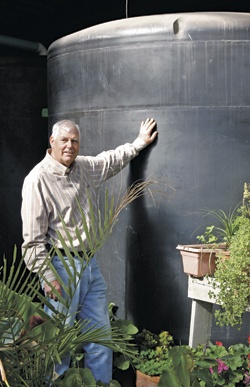When Billy Kniffen and his wife built their home near Menard six years ago, he knew that water would be a concern because wells dug on the property had never been productive, and the house was beyond access to city water. So Kniffen installed a rainwater harvesting system at his place, and he has not been without water since.
Rainwater harvesting is a system of capturing, diverting and storing rainwater for later use. The most common method employs a roof made of a smooth material, usually tin, to divert the rainfall into storage tanks. Rainwater gutters, connecting pipes and filters complete the most common system. A basic, “no-frills” 50-gallon home rainwater harvesting system generally costs about $50 in materials. More elaborate systems with pumps and pressure tanks, along with more advanced filtration systems and a chlorinator, can cost several thousand dollars. The expense depends on roof size, landscape area, amount of water storage desired, whether the water will be for potable or nonpotable purposes and other factors.
Kniffen has 15,000 gallons of storage for home use and another 1,500 gallons dedicated to his three raised-bed gardens. He collects rainwater from about 5,000 square feet of surface area and stores about 3,000 gallons of water for every inch of rainfall.
“I catch enough rainfall to take care of all my water needs,” Kniffen says. “I use it for everything—including my garden and landscaping. I use it as a water source and as a way to attract wildlife.”
Kniffen, previously the Texas AgriLife Extension Service agent for agriculture and natural resources in Menard County, now serves as the extension’s first water resource specialist dedicated solely to educating Texans about rainwater harvesting. Kniffen said that as far as he can tell, he is the first person in the country from any agency to deal with nothing but rainwater harvesting.
The job comes at a time when the state’s growing population is expected to exceed current projected water supplies. Kniffen believes that rainwater harvesting is part of the solution to the looming problem.
“Rainwater harvesting is one of the things we’re looking at,” he said. “We’ve put in demonstration models at several school districts and worked with extension agents, Master Gardeners and Master Naturalists all over the state to let them know that this is a good alternative.”
Some landowners use a rainwater harvesting system to provide an additional water source for wildlife and to supplement watering of livestock. Rainwater can be used to water livestock but only up to a point, Kniffen said.
“Livestock producers can’t rely on it too much because of how much water the animals need. If you’re on small acreage with just a horse or a couple of goats or something like that, it’s different,” he said. Cattle require from 7 to 18 gallons of water per day, horses need 8 to 18 gallons, and sheep and goats require 1 to 4 gallons. As a general rule, you should provide 2 gallons of water per 100 pounds of body weight, Kniffen said.
The Kniffen home uses about 70 gallons per day, and he estimates that he could still maintain enough water even if a drought dropped the yearly rainfall total to 9 inches.
“We haven’t had any problems,” he said.
Kniffen said rainwater harvesting systems have traditionally been used in West Texas, where average annual rainfall can amount to 10 inches or less. That is changing, he said. There is interest now in Central Texas, especially from Austin to Dallas, because of the region’s rapid population growth. One of the largest rainwater harvesting systems in America is at the Lady Bird Johnson Wildflower Center in Austin, where a 17,000-square-foot roof collects about 10,600 gallons for every inch of rain.
Kniffen delivered a talk to the 2007 Home Landscape and Garden Conference in Tyler on the benefits of rainwater harvesting in that area.
“East Texas gets a lot of rain, but it doesn’t come all at the same time,” he said. “There are periods of drought. Lakes get low. Even Lake Palestine has gone dry. When you look at how to conserve water and keep water there for your use in the home as well as outside, rainwater harvesting is one way to go.”
Rainwater harvesting has also been done in some of the most remote areas of the Trans-Pecos region of West Texas.
“They began using it (rainwater harvesting) a few years ago at a number of places down around Big Bend as part of an effort to reintroduce bighorn sheep into the area,” Kniffen said. “I saw the first of that, and now I see that same idea being applied all over the state.”
The Texas Commission on Environmental Quality developed guidelines for in-home rainwater use last year, and the Texas Legislature has endorsed rainwater use in state buildings. The Texas Water Development Board estimates that 38 billion gallons of water could be saved annually if only 10 percent of the roof area in Texas were used for rainfall harvest.
——————–
More information on rainwater harvesting in Texas can be found at http://rainwaterharvesting.tamu.edu.
Clay Coppedge is the state writer for Country World newspaper.


